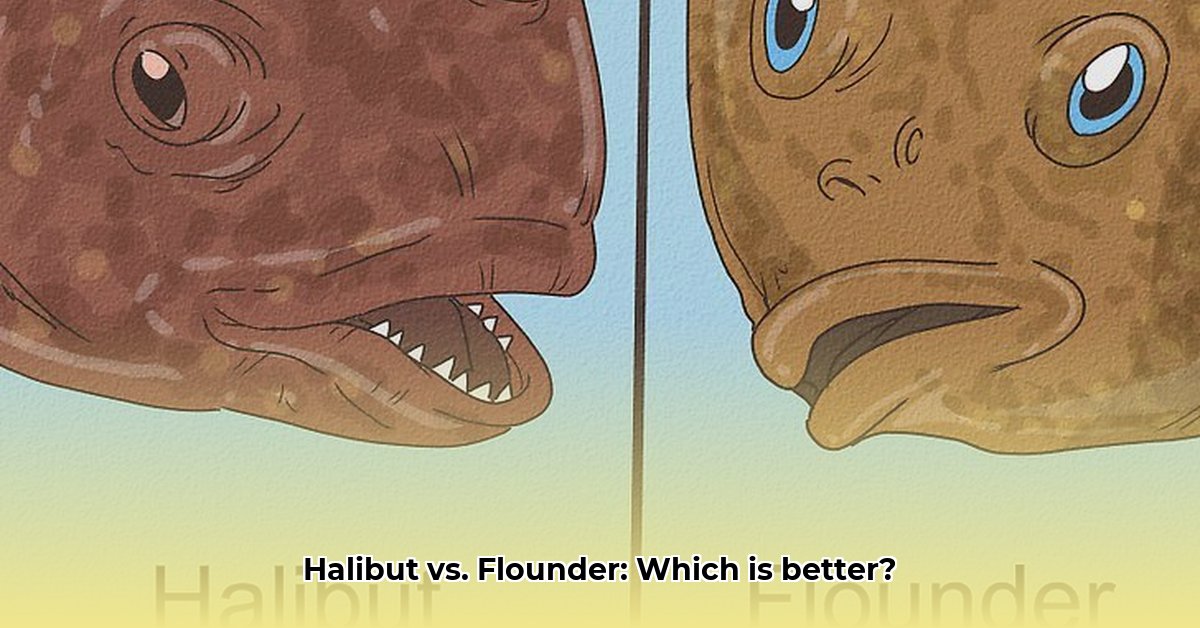Choosing between halibut and flounder can feel like navigating a culinary maze, but it doesn’t have to be. Both are delicious white fish, but they offer distinct differences that influence how you cook and enjoy them. Let’s dive in and explore the “Great Fish Face-Off” while considering sustainable seafood sourcing. For another white fish comparison, check out this halibut vs cod guide.
Size, Texture and Taste: Halibut versus Flounder Comparison
The most immediate difference you’ll notice is size. Halibut, the heavyweight champion of the sea, can easily tip the scales at over 100 pounds! Some Pacific halibut have been recorded at over 500 pounds. Flounder, on the other hand, is a much smaller fish, usually weighing less than 20 pounds. This size difference significantly impacts how these fish are caught, handled, and ultimately, presented on your plate. Larger halibut often require different fishing techniques and tend to be more expensive. Understanding the taste profiles and textures is also critical whether you’re a seasoned chef or a home cook.
Beyond size, the texture and taste are dramatically different. Halibut boasts a firm, meaty texture, similar to a nicely cooked chicken breast—robust enough to hold its own on the grill or in a hearty bake. Its flavor is fairly mild, with a subtle sweetness and buttery richness. Flounder, in contrast, offers a delicate, flaky texture, almost melt-in-your-mouth tender. Its flavor is similarly understated, clean, and subtle, essentially offering a blank canvas for bolder flavors. The delicate texture of flounder makes it ideal for absorbing flavors and sauces.
Ocean Habitats and Availability of Flat Fish
Understanding where these fish live helps explain some of their differences. Halibut prefer the chilly, deep waters of the North Atlantic and Pacific Oceans, often dwelling near the continental shelf. Flounder are found in shallower coastal areas, often near sandy or muddy bottoms, and can tolerate a wider range of water temperatures. This difference influences their availability and, consequently, the price you’ll pay at the fish counter. Halibut, being harder to catch due to their size and habitat, are generally pricier.
Nutritional Comparison: Omega-3 Fatty Acids and Health Benefits
Both halibut and flounder are excellent sources of protein, low in fat, and rich in essential nutrients. However, when it comes to omega-3 fatty acids—those heart-healthy fats—halibut generally comes out on top, with approximately twice the omega-3 content of flounder. The exact amount varies depending on the fish’s size, diet, and the location it was caught, but halibut tends to pack a slightly more potent dose of these beneficial fats, promoting cardiovascular health and reducing inflammation. Always check nutrition labels for the most precise information, as these figures can change based on a number of factors. Both fish are also good sources of Vitamin B12 and Selenium.
Cooking Methods and Recipe Ideas for Halibut and Flounder
Because of their contrasting textures, halibut and flounder respond best to different cooking methods. Halibut, with its firm texture, can withstand higher heat—think grilling, broiling, baking, or even searing. It’s a versatile fish that can stand up to bold flavors. Consider marinating halibut in a citrus-herb blend before grilling. Flounder, with its delicate flesh, is best treated gently. Pan-searing, steaming, poaching, or baking are all excellent choices. Overcooking can easily dry out this gentler fish, so keep an eye on the cooking time! A classic preparation for flounder involves a light dusting of flour before a quick pan-sear in butter.
Sustainable Seafood Choices: Making Responsible Decisions for Ocean Health
Both halibut and flounder populations face challenges due to overfishing. It’s crucial to choose sustainably sourced fish whenever possible. Look for certifications from reputable organizations like the Marine Stewardship Council (MSC) or the Aquaculture Stewardship Council (ASC), which promote responsible fishing and farming practices. Checking the labels and paying attention to where your fish comes from is a small step with big impacts on the health of our oceans. Supporting sustainable fishing helps ensure these delicious fish remain available for future generations. It is a small step with big impacts on the health of our oceans. “Choosing sustainably sourced seafood is an investment in the future health of our oceans,” said Dr. Ayana Johnson, a marine biologist and policy expert.
Price Tag and Budget Considerations for Seafood Lovers
The price difference between these two fish is quite noticeable. Halibut, due to its larger size, desirable texture, and higher omega-3 content, generally carries a higher price tag, making it a premium choice. Flounder, being more abundant and readily available, is typically more budget-friendly, making it a great option for those watching their spending. Prices can also fluctuate based on seasonality and location.
Halibut vs. Flounder: A Quick Reference Guide
| Feature | Halibut | Flounder |
|---|---|---|
| Size | Large (often over 100 lbs) | Smaller (typically under 20 lbs) |
| Texture | Firm, meaty | Delicate, flaky |
| Flavor | Mild, buttery, slightly sweet | Subtle, mild |
| Omega-3s | Generally higher | Lower |
| Price | Higher | Lower |
| Cooking Methods | Grilling, baking, broiling, searing, smoking | Pan-searing, steaming, poaching, baking |
| Habitat | Deep, cold ocean waters | Shallow, coastal waters |
| Sustainability | Varies; check for responsible sourcing labels | Varies; check for responsible sourcing labels |
| Mercury Level | Moderate | Lower |
Ultimately, the “better” fish depends entirely on your personal preferences and what you’re looking for in a meal. Whether you opt for the hearty halibut or the delicate flounder, remember to choose sustainably sourced seafood to enjoy these delicious fish responsibly. Happy cooking! Did you know that halibut’s firm texture is due to its higher collagen content, allowing it to withstand higher cooking temperatures? Flounder’s ability to camouflage itself on the ocean floor is a remarkable adaptation for survival.
How to Differentiate Halibut and Flounder Based on Nutritional Content
So, you’re standing in the fish market, faced with two flat, white beauties: halibut and flounder. How do you choose? Understanding their nutritional differences is key in determining your next meal. Is your primary goal consuming high levels of omega-3 fatty acids or a boost in selenium and vitamin B12?
Key Takeaways:
- Both halibut and flounder are lean, healthy fish, but their nutritional profiles differ.
- Halibut generally boasts higher protein and omega-3 fatty acid content, with up to twice as much omega-3 as Flounder.
- Flounder often contains more selenium and vitamin B12.
- Mercury levels are low in both, but flounder may be slightly lower, making it a safer choice for pregnant women.
- The “better” choice depends on your individual dietary needs and budget.
Unmasking the Nutritional Differences of Two Flat Fish
Halibut, a larger fish, often packs a more substantial protein punch. A 3-ounce serving of halibut provides around 19 grams of protein. It also tends to be richer in omega-3 fatty acids, those heart-healthy fats we all crave. Flounder, on the other hand, might not be as protein-dense, providing closer to 11 grams of protein per 3-ounce serving, but it often shines in other areas. It’s sometimes a superior source of selenium, a powerful antioxidant, and vitamin B12, crucial for nerve function and red blood cell formation. The mercury content in both is generally low, making them safe choices. However, flounder often scores slightly lower on the mercury scale.
Beyond the Numbers: Texture and Taste for Culinary Uses
Nutritional data is just part of the picture. Texture and taste significantly impact culinary choices. Halibut’s firmer flesh holds its shape beautifully on the grill or in a pan. It’s perfect for dishes needing structural integrity. Flounder’s delicate texture, however, is best suited for gentler cooking methods like poaching or sautéing; otherwise, overcooking it results in a mushy mess. Its subtle taste pairs well with lighter sauces. Consider flounder fillets pan-fried with lemon and capers for a light, flavorful dish.
A Quick Nutritional Comparison Table
| Feature | Halibut | Flounder |
|---|---|---|
| Protein | Higher (approx. 19g per 3oz) | Lower (approx. 11g per 3oz) |
| Omega-3s | Higher | Lower |
| Selenium | Lower | Higher |
| Vitamin B12 | Lower | Higher |
| Mercury | Low (slightly higher than flounder) | Low (slightly lower than halibut) |
| Texture | Firm, holds its shape well | Delicate, can become mushy if overcooked |
| Culinary Uses | Grilling, baking, pan-frying | Poaching, sautéing, baking |
Making the Right Choice for Your Taste Buds and Diet
Ultimately, the best choice depends on your individual preferences
- Wellness Fair Ideas for Work to Boost Employee Wellbeing - December 15, 2025
- Affordable Employee Wellness Fair Ideas for Any Budget - December 14, 2025
- Employee Wellness Programs Strategically Benefit Employee Health And Retention - December 13, 2025
















